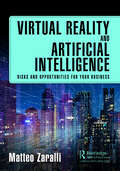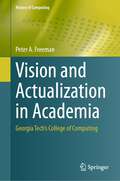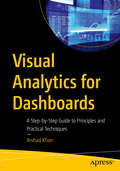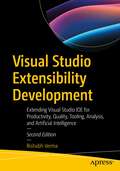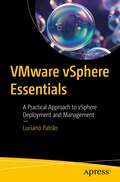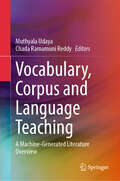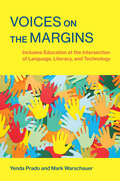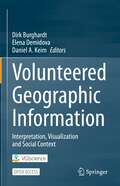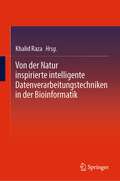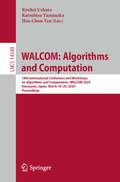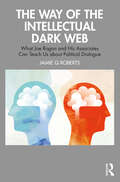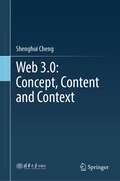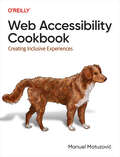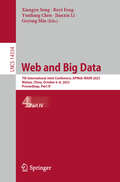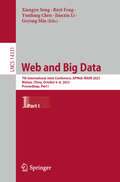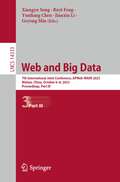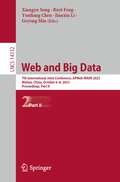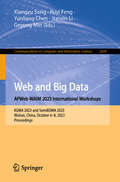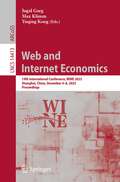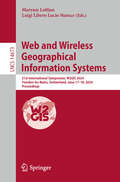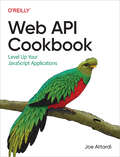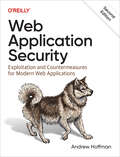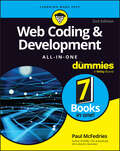- Table View
- List View
Virtual Reality and Artificial Intelligence: Risks and Opportunities for Your Business
by Matteo ZaralliTechnology is rapidly transforming the way people learn and train, and the integration of virtual reality (VR) and artificial intelligence (AI) could be the next big breakthrough. With the advent of Web 3.0 and the Metaverse, there are endless possibilities for creating immersive and engaging learning environments. However, there is also a need to address the risks and challenges that these technologies present.This book explores the risks and opportunities of VR and AI for coaching and training, with an eye toward the emerging trends of Web 3.0 and the Metaverse. Coaching and training have become increasingly important for companies seeking to develop and retain talent. With the advent of VR and AI technology, there is an opportunity to create immersive and engaging learning environments that could greatly enhance the learning experience. However, there are also risks associated with the use of these technologies, such as data privacy and cybersecurity.This book provides an in-depth analysis of the risks and opportunities of VR and AI for coaching and training, to help startup and business executives understand how to use these technologies responsibly and effectively. We need a new perspective. The book discusses the intersection of various major subjects and topics: business, innovation, technology, and philosophy in terms of critical thinking. The transition we are experiencing through this new Intelligent Revolution is very important, and soon everyone will witness the shift from e-learning to v-learning.
Vision and Actualization in Academia: Georgia Tech’s College of Computing (History of Computing)
by Peter A. FreemanAlthough difficult, change in academic structures is necessary today, especially in fast-changing fields today such as biology, computing, management, the social sciences, and others. This includes changes within existing organizations as well as creation of new structures and reorganizations or eliminations of older ones. This narrative attempts first to document the historical rise of an organization, Georgia Tech’s College of Computing, that has touched and successfully changed the lives of thousands of people. Second, it aims to identify and explicate some of what has led to this widely acknowledged success. The book provides a chronological narrative that highlights major changes taken under each successive leader. These changes have built on one another, knowingly or otherwise, to create a growing organization that rivals in size and prominence longer established parts of the university. The case study, while of an academic organization focused on computing, provides general lessons applicable almost anywhere. Topics and features: Discusses the nature and uses of visions, both general and specificShows how visions can be used to drive specific actions and resource allocationsIllustrates the choice and use of enduring organizational principlesOutlines a simple strategic-planning method and its applicationIndicates results of this overall approach This book will be of interest to anyone interested in organizational change, especially in academia, and to those interested in Georgia Tech. It will also appeal to policymakers in education, government, and industry; as well as anyone interested in the historical growth of the computing milieu broadly. Peter A. Freeman was Founding Dean and Professor in the College of Computing at Georgia Tech from 1990 to 2002. Today he is an Emeritus Dean and Professor.
Visual Analytics for Dashboards: A Step-by-Step Guide to Principles and Practical Techniques
by Arshad KhanThis book covers the key principles, best practices, and practical techniques for designing and implementing visually compelling dashboards. It explores the various stages of the dashboard development process, from understanding user needs and defining goals, to selecting appropriate visual encodings, designing effective layouts, and employing interactive elements. It also addresses the critical aspect of data storytelling, examining how narratives and context can be woven into dashboards to deliver impactful insights and engage audiences. Visual Analytics for Dashboards is designed to cater to a wide range of readers, from beginners looking to grasp the fundamentals of visual analytics, to seasoned professionals seeking to enhance their dashboard design skills. For different types of readers, such as a data analyst, BI professional, data scientist, or simply someone interested in data visualization, this book aims to equip them with the knowledge and tools necessary to create impactful dashboards. What you’ll learn The principles of data visualization How to create effective dashboards Meet all the requirements for visual analytics/data visualization/dashboard courses Deepen understanding of data presentation and analysis How to use different kinds of tools for data analysis, such as scorecards and key performance indicators Who This Book Is For Business analysts, data analysts, BI professionals, end-users, executives, developers, as well as students in dashboards, data visualizations, and visual analytics courses.
Visual Studio Extensibility Development: Extending Visual Studio IDE for Productivity, Quality, Tooling, Analysis, and Artificial Intelligence
by Rishabh VermaMaster Visual Studio extensibility for an enhanced Visual Studio IDE experience. This book is a comprehensive guide that covers every facet of developing, debugging, and publishing extensions that amplify your productivity, tooling, and analysis within the Visual Studio IDE. This new edition is updated for Visual Studio 2022, which is the latest and greatest version of Visual Studio. Since the last edition, Artificial Intelligence (AI) has taken the world by the storm. This revised edition demonstrates how AI can take your extensions to unparalleled heights using ChatGPT. The book begins with an introduction to the essential concepts of Visual Studio, including data structures and design patterns before diving into the fundamentals of the Visual Studio extensibility model. Here you will learn the anatomy of a VSIX and how extensions are discovered and loaded in Visual Studio. Next, you will explore the extensibility model and see how various extensions, such as menus, commands, and tool windows can be plugged into Visual Studio. Moving forward, you’ll cover developing VS extensions and how they can be made configurable by customizing the UI and options page, and you’ll learn to develop a VS extension that leverages ChatGPT. Next, you will see how to extend the most often used component of Visual Studio, the code editor, before creating your own sample code snippets and templates. This is followed by a demonstration of how to deploy extensions using continuous integration (CI). Finally, you will learn tips and tricks for Visual Studio and its extensibility, along with a few highly valuable extensions. After reading Visual Studio Extensibility Development, you will be able to develop, debug, customize, and deploy extensions in Visual Studio IDE. What You Will Learn Master the art of personalizing extensions through the creation of dedicated tools option pagesExtend commands, editor, and tool window of Visual StudioSeamlessly integrate artificial intelligence in Visual Studio extensionsCreate project templates, item templates, and code snippets to streamline your development processEnhance IntelliSense for your custom project needsPublish your extension in the Visual Studio marketplace Who This Book Is For Developers, Programmers, Engineers, Architects, Instructors, Innovators, Students and Technology enthusiasts leveraging Visual Studio IDE.
VMware vSphere Essentials: A Practical Approach to vSphere Deployment and Management
by Luciano PatrãoThis book fills a vacuum in the market for high-quality information on a VMware vSphere system and offers a thorough introduction to VMware virtualization. Written for novices and those seeking more information about vSphere, this book walks you through its key concepts and technology, such as vSphere infrastructure creation, maintenance, and performance for beginners and advanced users.You'll take a step-by-step approach to guarantee you grasp the fundamental concepts and practical procedures required to construct and manage virtual machines in a VMware vSphere system. You'll explore the key components of vSphere with detail and explanation for each feature, including the hypervisor, networking, storage, and high availability, unravelling their intricacies and highlighting best practices.This book provides full VMware knowledge to develop, set up, and maintain vSphere environments that meet modern computing needs. It also features advanced topics, such as resource optimization, performance monitoring, advanced settings, and automation, empowering you to take your virtualization skills to the next level. VMware vSphere Essentials uses a unique step-by-step instructions designed to provide a high-level understanding, accompanied by illustrative images. What You'll LearnEnhance network efficiency with advanced vSphere LACP setupConfigure and manage virtual machines in vSphereImplement vSphere networking and storage Explore advanced vSphere features, such as DRS, HA, and fault toleranceMaster seamless VM migration techniquesOptimize hardware utilization with direct path I/O passthroughWho This Book Is ForSystem administrators, advanced vSphere administrators, and IT professionals pursuing VMware certifications
Vocabulary, Corpus and Language Teaching: A Machine-Generated Literature Overview
by Muthyala Udaya Chada Ramamuni ReddyThis book is the result of a collaboration between a human editor and an artificial intelligence algorithm to create a machine-generated literature overview of research articles analyzing the importance of ESL/EFL vocabulary and corpus studies. It is a new publication format in which state-of-the-art computer algorithms are applied to select the most relevant articles published in Springer Nature journals and create machine-generated literature reviews by arranging the selected articles in a topical order and creating short summaries of these articles.This comprehensive book explores ESL/EFL vocabulary and corpus studies from five main perspectives: acquisition, strategies, ICT, corpus, and current practices. The sections delve into topics such as the impact of technology on learning, the power of corpora in language education, and innovative vocabulary-development techniques.This book is an essential resource for researchers, educators, and language facilitators seeking a deeper understanding of vocabulary within ESL/EFL teaching and learning contexts.
The Vogue of Managing People in Workplace (Innovations in Sustainable Technologies and Computing)
by Soumi Majumder Nilanjan DeyThis book provides a detailed vogue picture of workforce management. Nowadays, the methodology of people management has been more advanced and dynamic; it becomes highly competitive. Keeping in mind the significance of economic and social development of the country, the author has tried to draw attention on innovative and creative practices of workforce retention in business. The book provides an idea on the way of merchandising with people, cultural dynamics with impacted leadership, investment in people for organizational transformation and the future of people management with artificial intelligence.
Voices on the Margins: Inclusive Education at the Intersection of Language, Literacy, and Technology
by Yenda Prado Mark WarschauerA rich view of inclusive education at the intersection of language, literacy, and technology—drawing on case study research in a diverse full-inclusion US school before, during, and after the COVID-19 pandemic.Despite advancing efforts at integration, the segregation of students with disabilities from their nondisabled peers persists. In the United States, 34 percent of all students with disabilities spend at least 20 percent of their instructional time in segregated classrooms. For students with intellectual or multiple disabilities, segregated placement soars to 80 percent. In Voices on the Margins, Yenda Prado and Mark Warschauer provide an ethnography of an extraordinary full-inclusion public charter school in the western United States—Future Visions Academy. And they ask: What does it mean to be inclusive in today&’s schools with their increasingly pervasive use of digital technologies?Voices on the Margins examines the ways digital technologies support inclusion and language and literacy practices for culturally and linguistically diverse children with and without disabilities. A wide range of qualitative data collected in the case study illuminates three central themes: (1) the kinds of social organization that allow a fully inclusive environment for children with disabilities to thrive, (2) the ways that digital technologies can be used to help students express their voice and agency, while developing language and literacy skills, and (3) the ways that digital technologies can be used to foster stronger networks and connections between students, teachers, staff, and parents.
Volunteered Geographic Information: Interpretation, Visualization and Social Context
by Dirk Burghardt Elena Demidova Daniel A. KeimThis open access book includes methods for retrieval, semantic representation, and analysis of Volunteered Geographic Information (VGI), geovisualization and user interactions related to VGI, and discusses selected topics in active participation, social context, and privacy awareness. It presents the results of the DFG-funded priority program "VGI: Interpretation, Visualization, and Social Computing" (2016-2023).The book includes three parts representing the principal research pillars within the program. Part I "Representation and Analysis of VGI" discusses recent approaches to enhance the representation and analysis of VGI. It includes semantic representation of VGI data in knowledge graphs; machine-learning approaches to VGI mining, completion, and enrichment as well as to the improvement of data quality and fitness for purpose. Part II "Geovisualization and User Interactions related to VGI" book explores geovisualizations and user interactions supporting the analysis and presentation of VGI data. When designing these visualizations and user interactions, the specific properties of VGI data, the knowledge and abilities of different target users, and technical viability of solutions need to be considered. Part III "Active Participation, Social Context and Privacy Awareness" of the book addresses the human impact associated with VGI. It includes chapters on the use of wearable sensors worn by volunteers to record their exposure to environmental stressors on their daily journeys, on the collective behavior of people using location-based social media and movement data from football matches, and on the motivation of volunteers who provide important support in information gathering, filtering and analysis of social media in disaster situations.The book is of interest to researchers and advanced professionals in geoinformation, cartography, visual analytics, data science and machine learning.
Von der Natur inspirierte intelligente Datenverarbeitungstechniken in der Bioinformatik
by Khalid RazaDieses Buch umfasst und beschäftigt sich mit den jüngsten Fortschritten und modernsten Anwendungen von naturinspirierten Computertechniken (NIC) im Bereich der Bioinformatik und der Computerbiologie, die die medizinischen Wissenschaften bei verschiedenen klinischen Anwendungen unterstützen können. Dieser Sammelband befasst sich mit den grundlegenden Anwendungen, dem Umfang und den Zukunftsperspektiven von NIC-Techniken in der Bioinformatik, einschließlich der Erstellung von Genomprofilen, der Klassifizierung von Genexpressionsdaten, der DNA-Berechnung, der System- und Netzwerkbiologie, der Lösung von Komplikationen bei personalisierten Therapien, der antimikrobiellen Resistenz bei bakteriellen Krankheitserregern und der computergestützten Entwicklung von Arzneimitteln, deren Entdeckung und Therapie. Darüber hinaus wird die Rolle von NIC-Techniken bei verschiedenen Krankheiten und Störungen behandelt, einschließlich Krebserkennung und -diagnose, Brustkrebs, Erkennung von Lungenkrankheiten, Krankheits-Biomarkern und Identifizierung potenzieller Therapeutika.
Wachstum durch den Einsatz von Generativer KI: Funktionsweise und Anwendungsgebiete im Marketing (essentials)
by Bernhard WeckeDieses Buch bietet einen fundierten Einblick in die Relevanz von Generativer Künstlicher Intelligenz (KI) im Marketing. Neben einer kompakten Darstellung der Funktionsweise und Grenzen von Generativer KI wird ein umfassender Überblick über KI-basierte Medienformate gegeben.Anhand von Praxisbeispielen und konkreten Auswahlkriterien erfahren Sie, wie Sie geeignete Anwendungsfälle für Generative KI identifizieren und in Ihre Marketingstrategie integrieren können. .
WALCOM: 18th International Conference and Workshops on Algorithms and Computation, WALCOM 2024, Kanazawa, Japan, March 18–20, 2024, Proceedings (Lecture Notes in Computer Science #14549)
by Ryuhei Uehara Katsuhisa Yamanaka Hsu-Chun YenThis book constitutes the refereed proceedings of the 18th International Conference and Workshops on Algorithms and Computation, WALCOM 2024, held in Kanazawa, Japan, during March 18–20, 2024. The 28 full papers presented in this book, together with two extended abstracts of invited talks, were carefully reviewed and selected from 80 submissions. They cover diverse areas of algorithms and computation, that is, approximation algorithms, algorithmic graph theory and combinatorics, combinatorial algorithms, combinatorial optimization, computational biology, combinatorial reconfiguration, computational complexity, computational geometry, discrete geometry, data structures, experimental algorithm methodologies, graph algorithms, graph drawing, parallel and distributed algorithms, parameterized algorithms, parameterized complexity, network optimization, online algorithms, randomized algorithms, and string algorithms.
The Way of the Intellectual Dark Web: What Joe Rogan and His Associates Can Teach Us about Political Dialogue
by Jamie Q RobertsRoberts presents a rigorous and accessible assessment of the Intellectual Dark Web’s origins, shared philosophy, cultural importance, and limitations. Since the mid-2010s, the Intellectual Dark Web (IDW) has been an unprecedented cultural and intellectual phenomenon. Using primarily podcasts and YouTube videos, a new generation of public intellectuals has appeared, loosely coalesced, and gained a vast global audience. This movement has encompassed a range of individuals, notably Joe Rogan, Jordan Peterson, Eric and Bret Weinstein, Ben Shapiro, Heather Heying, and Sam Harris. Other names more broadly associated with the grouping have included Steven Pinker, Jonathan Haidt, Elon Musk, Niall Ferguson, and Stephen Fry. There is a sprawling and ever-growing list of those who have appeared on IDW podcasts and videos, started their own podcasts along similar lines, and share a general ethos. It is a dispersed movement, but a significant one, given the reach of these various online outlets is in the millions globally. Roberts draws together and synthesises the core ideas espoused by the members of this movement and critically assesses its origins, coherence, and the impact it has had on politics and public discourse. He asks – to what extent has the IDW lived up to its professed goal of moving beyond polarisation and radicalisation? An insightful read both for followers of the IDW looking for a coherent and critical overview and for students of popular culture looking to understand this massive but decentralised popular intellectual movement.
Web 3.0: Concept, Content and Context
by Shenghui ChengAs technology continues to advance, the Internet is evolving into what is often referred to as Web 3.0. This book aims to achieve three main objectives, first, it introduces Web 3.0 systematically and comprehensively, providing readers with a foundational understanding of its concepts and characteristics. Second, it analyzes the inevitability and development necessity of Web 3.0, as well as its potential future possibilities and transformative effects. Finally, it explores Web 3.0 through comparative analysis, discussing its relationship with the metaverse as well as how individuals and organizations can seize the opportunities presented by Web 3.0. Various topics related to Web 3.0, including its infrastructure, development facilities, scenario applications, technology stacks, and industry applications such as decentralized applications (DApps) and Software-as-a-Service (SaaS) platforms are presented in the book. It delves into the ecosystem of Web 3.0, discussing decentralized autonomous organizations (DAOs), open finance (DeFi), cryptocurrencies, token economy, digital identity, creator economy, attention economy, and cyber-physical and human systems. Additionally, it addresses governance issues, security challenges, development challenges, and legal and regulatory aspects associated with Web 3.0. Overall, Web 3.0: Concept, Content and Context provides readers with a comprehensive understanding of Web 3.0, its potential implications, and the opportunities for new industry models and business opportunities in the evolving Internet era.
Web Accessibility Cookbook
by Manuel MatuzovicFrontend developers have to consider many things: browser compatibility, usability, performance, scalability, SEO, and other best practices. But the most fundamental aspect of creating websites is one that often falls short: accessibility. Accessibility is the cornerstone of any website, and if a website is inaccessible, users won't be able to interact with it, obtain information, sign up for services, or buy products.The Web Accessibility Cookbook provides you with dozens of recipes to help you avoid these failures. You'll learn how to build common components, such as main navigation, filters, and dialogs, in an accessible manner. Each recipe not only explains how to build things but also why. Author Manuel Matuzovic provides the knowledge you need to create your own accessible components and address your users' varying needs, abilities, and preferences.With this practical guide, you will:Learn how to build websites that feature inclusive frontendsDiscover the common obstacles website users face every dayUnderstand how your decisions impact usersLearn how to build accessible frontends step-by-stepWrite high-quality markup and CSSEvaluate the accessibility of frontend components
Web and Big Data: 7th International Joint Conference, APWeb-WAIM 2023, Wuhan, China, October 6–8, 2023, Proceedings, Part IV (Lecture Notes in Computer Science #14334)
by Xiangyu Song Ruyi Feng Yunliang Chen Jianxin Li Geyong MinThe 4-volume set LNCS 14331, 14332, 14333, and 14334 constitutes the refereed proceedings of the 7th International Joint Conference, APWeb-WAIM 2023, which took place in Wuhan, China, in October 2023. The total of 138 papers included in the proceedings were carefully reviewed and selected from 434 submissions. They focus on innovative ideas, original research findings, case study results, and experienced insights in the areas of the World Wide Web and big data, covering Web technologies, database systems, information management, software engineering, knowledge graph, recommend system and big data.
Web and Big Data: 7th International Joint Conference, APWeb-WAIM 2023, Wuhan, China, October 6–8, 2023, Proceedings, Part I (Lecture Notes in Computer Science #14331)
by Jianxin Li Geyong Min Xiangyu Song Ruyi Feng Yunliang ChenThe 4-volume set LNCS 14331, 14332, 14333, and 14334 constitutes the refereed proceedings of the 7th International Joint Conference, APWeb-WAIM 2023, which took place in Wuhan, China, in October 2023. The total of 138 papers included in the proceedings were carefully reviewed and selected from 434 submissions. They focus on innovative ideas, original research findings, case study results, and experienced insights in the areas of the World Wide Web and big data, covering Web technologies, database systems, information management, software engineering, knowledge graph, recommend system and big data.
Web and Big Data: 7th International Joint Conference, APWeb-WAIM 2023, Wuhan, China, October 6–8, 2023, Proceedings, Part III (Lecture Notes in Computer Science #14333)
by Jianxin Li Geyong Min Xiangyu Song Ruyi Feng Yunliang ChenThe 4-volume set LNCS 14331, 14332, 14333, and 14334 constitutes the refereed proceedings of the 7th International Joint Conference, APWeb-WAIM 2023, which took place in Wuhan, China, in October 2023. The total of 138 papers included in the proceedings were carefully reviewed and selected from 434 submissions. They focus on innovative ideas, original research findings, case study results, and experienced insights in the areas of the World Wide Web and big data, covering Web technologies, database systems, information management, software engineering, knowledge graph, recommend system and big data.
Web and Big Data: 7th International Joint Conference, APWeb-WAIM 2023, Wuhan, China, October 6–8, 2023, Proceedings, Part II (Lecture Notes in Computer Science #14332)
by Jianxin Li Geyong Min Xiangyu Song Ruyi Feng Yunliang ChenThe 4-volume set LNCS 14331, 14332, 14333, and 14334 constitutes the refereed proceedings of the 7th International Joint Conference, APWeb-WAIM 2023, which took place in Wuhan, China, in October 2023. The total of 138 papers included in the proceedings were carefully reviewed and selected from 434 submissions. They focus on innovative ideas, original research findings, case study results, and experienced insights in the areas of the World Wide Web and big data, covering Web technologies, database systems, information management, software engineering, knowledge graph, recommend system and big data.
Web and Big Data. APWeb-WAIM 2023 International Workshops: KGMA 2023 and SemiBDMA 2023, Wuhan, China, October 6–8, 2023, Proceedings (Communications in Computer and Information Science #2094)
by Jianxin Li Geyong Min Xiangyu Song Ruyi Feng Yunliang ChenThis proceedings constitutes selected papers from the Workshops KGMA and SemiBDMA which were held in conjunction with APWeb-WAIM 2023 which took place in Wuhan, China, during October 6-8, 2023. The 7 full papers included in this book were carefully reviewed and selected from 15 papers submitted to these workshops. They focus on new research approaches on the theory, design, and implementation of data management systems.
Web and Internet Economics: 19th International Conference, WINE 2023, Shanghai, China, December 4–8, 2023, Proceedings (Lecture Notes in Computer Science #14413)
by Jugal Garg Max Klimm Yuqing KongThis volume LNCS 14413 constitutes the refereed proceedings of the 19th International Conference, WINE 2023, in December 2023 held in Shanghai, China. The 37 full papers presented together with 29 one-page abstracts were carefully reviewed and selected from 221 submissions. The WINE conference series aims to exchange research ideas in a diverse area of application at the intercept of theoretical computer science , artificial intelligence, operations research, and economics.
Web and Wireless Geographical Information Systems: 21st International Symposium, W2GIS 2024, Yverdon-les-Bains, Switzerland, June 17–18, 2024, Proceedings (Lecture Notes in Computer Science #14673)
by Maryam Lotfian Luigi Libero Lucio StaraceThis book constitutes the refereed proceedings of the 21st International Symposium on Web and Wireless Geographical Information Systems, W2GIS 2024, held in Yverdon-les-Bains, Switzerland, during June 18–19, 2024. The 8 full papers and 7 short papers included in this book were carefully reviewed and selected from 20 submissions. The book also contains one invited talk. They were organized in topical sections as follows: Spatiotemporal Data Analysis, Open Data and Reproducible Research, Geospatial Technologies and Tools, Advanced Computing and GIS Applications, Transportation Applications, and Doctoral Symposium.
Web API Cookbook
by Joe AttardiJavaScript gives web developers great power to create rich interactive browser experiences, and much of that power is provided by the browser itself. Modern web APIs enable web-based applications to come to life like never before, supporting actions that once required browser plug-ins. Some are still in an experimental stage, but many are ready for use today.With this hands-on cookbook, author Joe Attardi helps you explore the powerful APIs available in modern browsers and guides you through the specific tasks that they unlock. Because these features are web standards, there is comprehensive documentation available from trusted resources such as MDN Web Docs. The knowledge you'll gain is transferable across different companies and projects.Learn the breadth of functionality available in modern browser APIsExplore future APIs that are still in an experimental stageDiscover newer elements, such as dialog that replaces the need for a third-party libraryBuild more powerful and interactive web applications using native APIsUnderstand the permissions model used by the browser to unlock functionality such as geolocation and push notifications
Web Application Security
by Andrew HoffmanIn the first edition of this critically acclaimed book, Andrew Hoffman defined the three pillars of application security: reconnaissance, offense, and defense. In this revised and updated second edition, he examines dozens of related topics, from the latest types of attacks and mitigations to threat modeling, the secure software development lifecycle (SSDL/SDLC), and more.Hoffman, senior staff security engineer at Ripple, also provides information regarding exploits and mitigations for several additional web application technologies such as GraphQL, cloud-based deployments, content delivery networks (CDN) and server-side rendering (SSR). Following the curriculum from the first book, this second edition is split into three distinct pillars comprising three separate skill sets:Pillar 1: Recon—Learn techniques for mapping and documenting web applications remotely, including procedures for working with web applicationsPillar 2: Offense—Explore methods for attacking web applications using a number of highly effective exploits that have been proven by the best hackers in the world. These skills are valuable when used alongside the skills from Pillar 3.Pillar 3: Defense—Build on skills acquired in the first two parts to construct effective and long-lived mitigations for each of the attacks described in Pillar 2.
Web Coding & Development All-in-One For Dummies
by Paul McFedriesLearn the in-demand skills that let you turn lines of code into websites and apps Web Coding & Development All-in-One For Dummies is a one-stop resource for would-be developers who need guidance on the languages and steps used to build websites and applications. Learn the coding ropes and expand your existing skillset with this easy-to-understand guide. In these complete mini-books, you’ll walk through the basics of web development, structuring a page, building and processing web forms, and beyond. Learn how to build a website or create your very own app with the advice of web coding and development experts. This edition expands JavaScript and CSS coverage while providing new content on server-side coding and the development stack. Get essential knowledge of how web development works—even if you’ve never written a line of code in your life Learn HTML, CSS, JavaScript, and other languages essential for building websites and apps Discover how to make optimize your sites and apps for mobile devices Expand on what you already know and improve your employabilityThis Dummies All-in-One is great for you if want to develop coding skills but don’t have a programming background. It’s also perfect for professionals looking to brush up on their web development skills and get up to date on the latest trends and standards.
